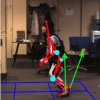Free Online Productivity Tools
i2Speak
i2Symbol
i2OCR
iTex2Img
iWeb2Print
iWeb2Shot
i2Type
iPdf2Split
iPdf2Merge
i2Bopomofo
i2Arabic
i2Style
i2Image
i2PDF
iLatex2Rtf
Sci2ools
ICCV
2009
IEEE
2009
IEEE
Estimating Contact Dynamics
Motion and interaction with the environment are fundamentally
intertwined. Few people-tracking algorithms exploit
such interactions, and those that do assume that surface
geometry and dynamics are given. This paper concerns
the converse problem, i.e., the inference of contact and environment
properties from motion. For 3D human motion,
with a 12-segment articulated body model, we show how
one can estimate the forces acting on the body in terms
of internal forces (joint torques), gravity, and the parameters
of a contact model (e.g., the geometry and dynamics
of a spring-based model). This is tested on motion capture
data and video-based tracking data, with walking, jogging,
cartwheels, and jumping.
| Added | 13 Jul 2009 |
| Updated | 10 Jan 2010 |
| Type | Conference |
| Year | 2009 |
| Where | ICCV |
| Authors | Marcus A. Brubaker Leonid Sigal David J. Fleet |
Comments (0)

